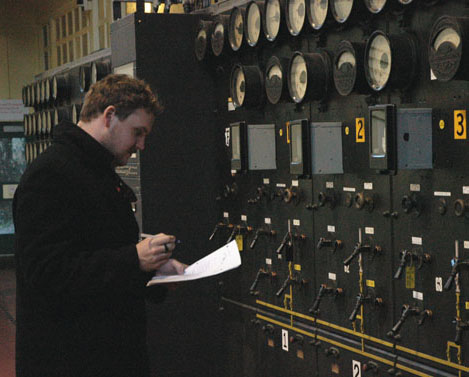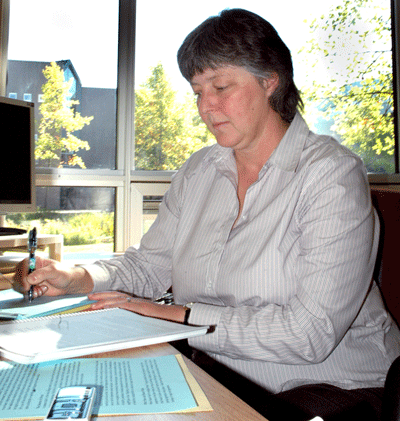Environment students embark on a dam field trip
November 7, 2010 by Stu Gallacher · Leave a Comment
Physics students from the environmental protection technology program at Kwantlen woke up at the crack of dawn on Thursday for a field trip to the hydroelectric dam at Stave Falls.
Eight second-year students and one professor arrived in the Richmond campus parking lot to board school bus for a 7:30 a.m. departure to Mission where the dam is located.
The original Stave Falls dam has been out of commission since 2000, but remains open to the public as a museum, which provides educational and entertaining tours.
“I enjoyed the tour and the dam was interesting, but it was an early time for a field trip,” says Neil Brooks, who is a second-year student.
“It’s all about learning application and seeing real life examples of what we study in class,” says John Currie who is also a second-year student.
The EPT students have been studying an array of alternative energy sources, conducting in-field research and collecting data for analysis, including their most recent garbage audit of the Richmond campus.
“We’re learning about various sources of energy that are economical for B.C. We can’t do nuclear power because we’re too close to a fault line,” Currie said.
“You have to assume that an earthquake will happen, and with a power plant a serious blast could occur,” Brooks added.
Currie points out that aside from fossil fuel, wind, solar and hydro are the most feasible and environmentally friendly sources of alternative energy. However, solar has its setbacks, “It’s not the way to go,” said Currie.
“Solar energy isn’t an efficient source because of our weather and latitude. The sun’s rays hit us at a low angle and it’s not always sunny. It’s different if you’re in Arizona or the desert,” said Brooks.
Currie and Brooks agree that for B.C., dams are the most effective and sustainable way to produce electricity. “When you consider the density of water, you realize how much power it can generate when it falls. One cubic meter of water weighs ton,” Currie said.
“They’re planning to build another dam in Peace River. All that energy contributes to the grid across North America,” Brooks said. “Energy that we buy.”
Audio: Kwantlen Chronicle podcast, volume two
October 18, 2010 by Talysa Dhahan · 1 Comment
[audio:podcast_2.mp3]
Talysa Dhahan and Brian Russell discuss parking at the Surrey campus, and listen to what students have to say about the situation, as well as covering the CIBC Run for the Cure, which took place on Oct. 3.
Kwantlen, Simply Computing team up to bring new store to Surrey campus
October 12, 2010 by Lucas Meneses-Skoda · Leave a Comment
Kwantlen is about to become a little more Mac-friendly, with an Apple retailer will begin operating out of Kwantlen Surrey’s bookstore at the end of October.
Students and staff will be able to take advantage of educational discounts on Apple products as well as software by Adobe and Microsoft, offered by Simply Computing
Kwantlen students have mixed opinions on whether the store will be useful.
“I don’t know if I’d ever use it,” said Andy Sheppard, a Kwantlen psychology student.
Rahil Faruqi, a Kwantlen student who is taking a double minor in English and philosophy, is a Mac user who welcomes the new addition.
“There aren’t many stores that focus mainly on Macs,” he said. “Seems okay. I don’t see any reason why it shouldn’t be.”
Anish Koirala, an accounting student, also agrees that it could benefit a lot of students.
“I don’t really use Mac as much, but I can assume somebody else would. I think it’s a good thing,” he says.
Simply Computing, which has several retail stores in the Lower Mainland, is, according to its website, the “largest Apple specialty dealer in British Columbia. The store, which will occupy a small portion of the bookstore’s space, will also provide hardware upgrade and rental services.
Food fight at Kwantlen’s Surrey campus
October 7, 2010 by Jeff Groat · 1 Comment
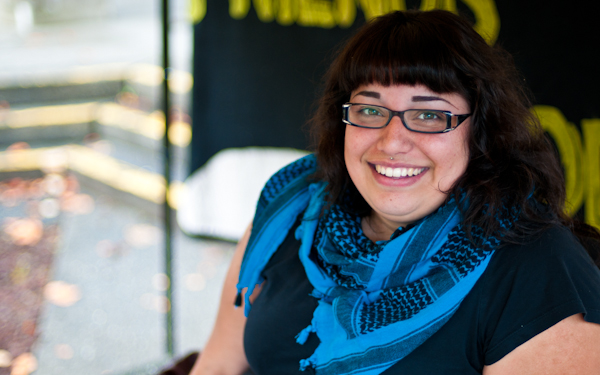
Eva Botton is one of the lead organizers of Friends 4 Food, a vegan food provider at Kwantlen's Surrey Campus. Photo by Max Hirtz
Friends 4 Food is not friends with Sodexo.
The reactive Friends 4 Food was formed in opposition to what they see as “a corporate bully”, Sodexo, moving in as operators of Kwantlen’s cafeterias through what they say is an all-too-murky process.
Friends 4 Food is run by a small group of criminology students and serves vegan food to students in the Surrey campus courtyard four days a week, offering an alternative to what F4F sees as overly expensive and unhealthy food, provided by Sodexo at Kwantlen’s cafeterias.
In the first week of operations, F4F was shutdown by Fraser Health Authority and slapped with $615 in fines for various health code violations, but not before being warned by Kwantlen administration of the potential health violations and of not properly booking space in the courtyard at Surrey Campus.
The idea was to serve vegan food by donation to students who don’t wish to spend their money at Sodexo.
“We thought we’d call for a boycott, but we can’t really call for a boycott if we have no means for students to boycott it,” said Eva Botten, who is a lead organizer of F4F.
Started as a research project for a criminology class, F4F organizers looked into the history of the company now running the cafeteria at the school.
“So we’re trying to get [Sodexo] out,” Botten said.
On the Surrey campus, there are other food options, such as the student-run Grassroots Café, but campuses in Richmond, Langley and Cloverdale only have Sodexo-run cafeterias.
F4F has gained wide support from Kwantlen’s criminology faculty in its vocal protests against Sodexo on one side, but has been dealing with Kwantlen aministration and policy on the other.
“In an era where there is so much student indifference or apathy, to have a student who is smart and politically engaged and have some political moxie, is a student to be celebrated,” said Hollis Johnson, the criminology professor who assigned the project.
Johnson also harkened back to an incident over the summer when Emery Warner, another Kwantlen criminology student, was booted off campus for refusing to show identification while handing out leaflets protesting Sodexo’s (at the time) new place on campus.
“Why would anybody get in trouble with the university and members of Sodexo for leafleting, handing out pieces of paper on a university, which to my mind is an open, public institution?” Johnson asked.
“Does that mean that anybody who walks on campus who we don’t like what they look like, or have to say, have to identify themselves?”
Joanne Saunders, Kwantlen’s Director of Marketing and Communications, said,”everyone is allowed to voice their opinion, I don’t have any concerns about that at all.”
“We’re just a university. The only reason we’re really involved, is we need to make sure that everything that the students are involved in, they’re in a safe environment… the proper space has been booked if they’re planning an event,” Saunders said.
Saunders said Kwantlen’s concerns were solely to do with the booking the required space and making sure the group meets the required Fraser Health regulations.
“We’re not there to hound the students to take up their time and ask them to do unreasonable things, but that is the procedure here at the university,” she said.
Jody Gordon, associate vice-president, students, wouldn’t comment on F4F, even though Friends 4 Food has singled out her office as the source of its troubles.
They believe that someone in Gordon’s office is responsible for tipping Fraser Health off, meaning that F4F was inspected even before the newly-opened Tim Horton’s on Surrey campus.
But according to Gordon, during the first week that F4F was set up serving food, Fraser Health Authority was alerted by an article that appeared on The Province’s website, prompting the health to shut F4F down amid concerns over food safety.
“Fraser Health [Authority] was involved… because of the much stricter regulations that Fraser Health has now on serving food. There’s other things that get involved with more than just occupying a small corner of a very large area,” Gordon said.
Johnson agrees.
“What about free speech? What about freedom of academic inquiry, just to name a few,” he asked.
And for Friends 4 Food, it’s a simple choice — a choice between student-made, vegan food — or not. “We’re only serving vegan food, and they do not offer vegan food,” Botten said.
“They offer carrot sticks, celery and French fries for vegan options.”
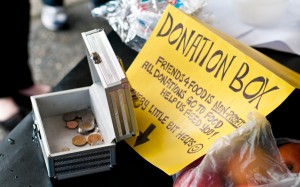
Friends 4 Food accepts donations for their services. Donations go right back into providing food to Kwantlen students. Photo by Max Hirtz
Kwantlen students dreaming of more sleep
October 3, 2010 by Jocelyn Gollner · Leave a Comment
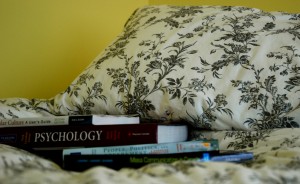
Many students are not getting the recommended 8 hours of sleep per night. (Photo by Jocelyn Gollner)
Kwantlen students may not be getting the sleep that they need.
The average amount of sleep that Kwantlen students get each night is six hours, based on an interview with 15 students. According to Dr. Najib Ayas, a member of the Sleep Disorders Program at UBC, students should be getting about eight.
Without a proper amount of sleep, Ayas says that “ your cognition won’t be as good, so you won’t be as alert. And you won’t be able to learn as well.”
If that doesn’t persuade you to get more sleep, he also says that sleep deprivation “affects your appetite hormones and that can actually lead to weight gain.” But with school, work, relationships, family commitments, sports, etc., getting more sleep can be easier said than done.
“I get like six or seven hours of sleep,” said Jennifer Chong, a student at Kwantlen. “If it were my choice I would get way more. Then I would feel way more relaxed.”
When asked what prevents her from getting more sleep, she said it’s mostly studying.
Jina Seo, a design student, also gets about six hours of sleep each night. Does she feel that that is enough?
“No, of course not,” she said.
RELATED: Stress relief for students is a no-brainer
Stress relief for students is a no-brainer
October 3, 2010 by Amanda Punshon · 1 Comment
Stress — The one thing everyone has and no-one wants…It is known to cause suicide, murder, tumours, AIDS, and cancer. So don’t get stressed out, ’cause stress SUCKS! Usually caused by something unfortunate, like death, job loss, woman loss, school, etc..” (Urban Dictionary).
While there is no scientific correlation between stress and tumours, AIDS or cancer, the author of that definition did get two things right: stress sucks, and it’s something we all have to deal with.
There are many different ways to manage it. Dr. Rod Le Blanc, a doctor of traditional Chinese medicine and acupuncturist, takes a drug-free approach. “Deep breathing and stretching has been the most important way to relieve stress for 4,000 years. Five, maybe. You could even say six.”
In addition to deep breathing and stretching, Dr. Le Blanc says that acupressure or massage can help.
“If you can team up with a friend who wants a massage and you want a massage, you can start working along the back of the spine. And do this gently, because some people are more sensitive than others and some people need more pressure than others, so you always have to be aware of who you’re dealing with…You start up at the top, at the C7 vertebrae and go along the spine.”
If you don’t have a friend who can help you, there are many devices that can do the same thing — even the corner of a doorway can be used to apply pressure along the spine, Dr. Le Blanc says.
Deep breathing and a simple mantra
Like Le Blanc, Jas Maan, a pharmacist at Shoppers Drug Mart on Nordel Way in Surrey, recommends deep breathing to relieve stress. “With breathing exercises, there’s also mantras you can use…I know one really popular one by this Vietnamese Buddhist monk; he put out a few books. One of the ones he said, it was a really simple one was “When I breathe in, I’m happy. When I breathe out, I’m relaxed.” And…[it's] as if someone was reassuring you.”
Maan says that moderate to heavy physical activity — activities such as running and hockey — is a great way to calm down. And as always, exercise and diet go hand-in-hand. “A lot of people find during exam season that they’re really blah…and one of the biggest reasons is that people don’t really pay attention to their nutrition. They’re eating X-Y-Z that’s probably more harmful than good. Things like just getting in their fruits and veggies can go a long way.”
There are also a variety of over-the-counter stress-relief aids.
“There’s Vitamin B-100. It’s a complex of vitamin B. It does help many processes of the body to help reduce stress levels,” Maan says. “There’s another herb as well called valerian root, you can take it at about 100-200mg at bedtime as needed.”
If stress is causing you to lose sleep, Maan recommends taking 25 to 50mg of Benadryl, an allergy medication, which contains the same active ingredient as over-the-counter sleep aids, but is much cheaper. Melatonin, a natural sleep hormone, will also help.
‘We’re never going to be stress-free’
Dawn Schell, a counsellor at Kwantlen’s Surrey campus, knows that “we’re never going to be stress-free. We need stress to hold us together as human beings.” She helps students figure out “the point at which it’s too much, it’s over the top and you can’t cope. We don’t want people to get to the point where they’re not coping at all and everything falls through the cracks.”
Schell advises students to make use of the resources available to them. Kwantlen offers seminars in time management, study skills and avoiding procrastination, all of which Schell identifies as causes of student stress. Students can also come in for individual appointments.
“We’re more than happy to help people sit down and figure out what’s going to work for them, what’s going to work in the immediate short-term, but also to help them look ahead to what are some things that they can learn so they can be more proactive in the future as well. Sometimes people just need to come in and let off some steam; they just need to unload somewhere and they can do that here.”
Schell says the first thing anyone has to do to relieve their stress “is learning about stress — how [I] personally respond to it, what’s stressful for [me]…and how does it affect me physically, and also how does it affect me mentally and how does it affect me emotionally. Because if I am the type of person who, for example, where I carry my stresses all physically, so then the body starts to tense up…then I need to learn how to use physical relaxation techniques.
“For some people it’s the brain that’s going. So how do you stop and calm your brain down enough so then you can refocus on whatever it is you need to do? For some people, it’s a combination. Sometimes they have to start with the mind and then go through the body.”
Building a relaxation toolbox
Once you’ve figured out your stress style, Schell advises assembling a personalized toolbox of relaxation techniques. For some people, that may involve setting deadlines or timelines, self-coaching or taking breaks.
“Sometimes it’s just about the mental break when you’re in school. Just let the brain go on neutral for a short period of time,” she says. There are a variety of online resources that students can use to help with deep relaxation.
If you’re already in the midst of a stressful situation, Schell says to “take five minutes and really sit down and figure out what’s the most important thing I need to do?… Maybe I need to back out of something that I’ve agreed to already. Some of it is, ‘How do I pull back a little bit, in a reasonable way?’ And some of that is really having a serious look at, ‘What is my top priority right now, and how can I do that?’”
Schell also advocates taking breaks.”You need to plan some fun or some relaxation or some time just for yourself in the midst of [stressful situations], because nobody can go through 24 hours-a-day, seven days-a-week without a break. That’s why we have eight-hour work days, that’s why people have lunch breaks…they need to build those kinds of opportunities in as well when they’re students. To just take a break and walk away, but know that there’s a time limit.”
Something as simple as getting up and moving around while studying can change the blood flow and wake you up, she says. And “if you really need a good break, find a movie that you find to be funny, or a show or something, because laughter sure helps a lot.”
Some online stress-relief resources
RELATED: Kwantlen students dreaming of more sleep February 16, 2010 by Abby Wiseman · 1 Comment In honour of the Lunar New Year the Langley Community Services Society hosted a multi-cultural performance at Langley campus on Feb. 6. Tai Chi Fan, Tango, Korean drums and Chinese Folk dance are just some of the many dances performed to welcome in the Year of the Tiger. Abby Wiseman and Kristi Jut captured the event on video. February 16, 2010 by Abby Wiseman · Leave a Comment A belly dancer entertains the crowd at the Circus of the Night fundraiser for Big Brothers of Greater Vancouver. (Abby Wiseman photo) Public relations students hosted a big bash for Big Brothers on Feb. 9 at the Circus of the Night fundraiser. Through ticket sales, donations and a silent auction, the second-year students raised $6,900, exceeding their goal of $6,000. The idea behind the event was to create an atmosphere where adults could feel like kids again, said student Alicia Bernbaum. Adding to the circus-vibe was the illusionist Yeeri, two belly dancers and tango dancers and candy apples, popcorn and “circus-tinis” were served. One of the evening’s highlights was a speech by big brother Steve Lee, who spoke about the positive effect being a big brother has on his life. Every year, second year PR students host a charity fundraiser as part of their event management course. Amelia Kennedy is the course instructor and has been a Big Sister for 11 years. She knows how difficult it can be for 24 people to organize an event, and said they did “really well.” “It’s really great to see all their hard work come together, and pull off a really great event, and raise a lot of money for Big Brothers,” said Kennedy. January 13, 2010 by Abby Wiseman · Leave a Comment Dur-e-aden was apprehensive about wearing the hijab when she first moved to Canada two years ago; in Pakistan wearing the hijab was normal, but in Canada she stands out when walks down the street. “It gives away my identity. Sometimes it’s good, sometimes it’s bad, but I’m ok with that,†said Dur-edan. “People should know who I am, like I don’t want to hide it or anything.†The Islamic religion requires a woman to dress modestly in loose clothing covering her body, except for her hands. The wearing of the hijab comes “The main purpose of it is to like protect your chastity, so you’re not supposed to reveal to much,†said Dur-e-aden, who started wearing the hijab when she was 14. Wearing the hijab doesn’t pose any problems for Dur-e-aden, who wears it everywhere she goes. She even has a hijab designed for playing sports. The Muslim population in B.C. is approximately 56,000, making it the third-largest such population in Canada after Ontario and Quebec, according to Statistics Canada. B.C. also has a large Sikh population. The 2001 census reported there are 125,000 Sikhs living in B.C., many living in Surrey and East Vancouver. Sumanpal Singh, a student at Kwantlen Polytechnic University said that those who choose not to wear the turban are not really Sikhs. Aulakh said that if you are living your life in the way of God but choose to not wear the turban, you are still Sikh. In Sikhism and Islam, the head coverings are gender-specific. In Judaism, men and women can wear a head covering called the yarmulka or kippah. A kippah is a small round hat that sits on the back of the head and, according to Infeld, is worn as a sign of respect to God and to all people. “I personally keep my head covered at all time,†said Infeld. “People who are more observant of Jewish law tend to do that.†To Infeld, a Jew does not have to where a kippah to be faithful. The Jewish population is small in B.C. with only 21,000 Jews. The Jewish community in Vancouver is concentrated around Oak Stre November 26, 2009 by Kirk Darbyshire · Leave a Comment If you have always wanted to study abroad but didn’t want to pay international student rates, then Kwantlen is for you this week. On the heels of International Education Week, Kwantlen is hosting information sessions for students who wish to apply to spend a semester studying at selected schools around the world. Journalism is one program that has been involved in student exchanges in the past. “All the journalism students who have gone on our European exchanges have pretty much had life-changing experiences,†said Beverley Sinclair, journalism program coordinator at Kwantlen. “Apart from the journalism education they get abroad, they get the experience of living in a different culture, surrounded by the history and beauty of Europe.†Kwantlen is currently accepting applications for exchanges during the 2010/11 academic year. Students who wish to apply must meet certain requirements to be considered for the exchange program. Applicants must have a minimum 2.67 GPA and have completed at least 30 university credits, 15 of which must have been done at Kwantlen. As well, once finished the exchange students must then return to Kwantlen and complete a minimum of nine more credits in the following semester. Along with academic requuirements, students are also responsible to cover their own costs of travel and living while on exchange. The one major advantage is that students will only have to pay tuition to Kwantlen, at the same rates they would pay if attending school in the Lower Mainland, and not the much higher international student fees traditionally charged visiting students. Students are often encouraged to do the exchange during the spring term, because European school semesters do not match up with Canadian ones. If a student went abroad in the fall semester of 2010, their European exchange wouldn’t end until four weeks into Kwantlen’s spring term. Also, if students spend the spring semester studying, it frees them up to travel around Europe for the summer before they have to return to Kwantlen for classes in the fall. Students who would like more information but who were unable to attend or missed the information sessions this week, can do so by contacting international programs and exchanges through e-mail at Internationalprograms@kwantlen.ca or by phone at 604-599-2255.
Video: Langley campus dances in the Year of the Tiger
Students raise big money for Big Brothers

Wearing their faith keeps their identity: headcoverings worn out of religious respect
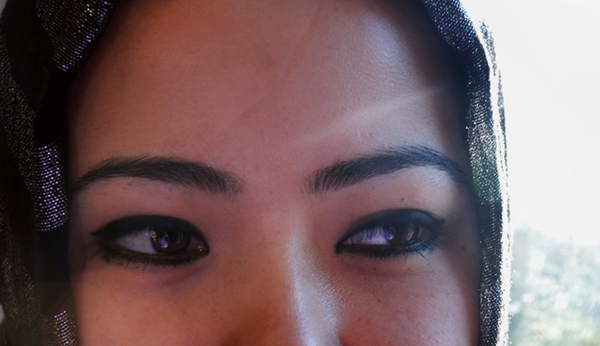
from the Qu’aran, the Islamic religious text, which says that Muslims, not just Muslim women, should dress modestly.
Dur-e-aden isn’t unique. Whether you’re wandering down Main Street or hanging out downtown, one of the most visible indication that Vancouver is a multicultural city is many people wear some form of head covering.
According to Pritam Singh Aulakh, president of the Akali Singh Society, Sikhism became prominent in the 15th century, and men began to wear the turban because it was considered unnatural and unreligious to cut the hair from any part of the body. Sikhs would wear a turban to keep their uncut hair neat and tidy.
“Wearing the turban is doing Gods will,†said Singh.
“Believing in God in Sikhism is doing good things…don’t tell lies, work for a living and share with others, and be truthful,†said Aulakh. “So if you are not practicing these things, then you are not Sikh.â€
The yarmulka and the kippah are the same thing, but, said Rabbi Infeld of the Beth Israel Synagogue, “yarmulka†is Yiddish, from a dialect of Hebrew that grew out of German. The word “kippah†is Hebrew.
Many Jews don’t wear the kippah all the time, many wear it only when praying and eating.Students exchange culture and classrooms


